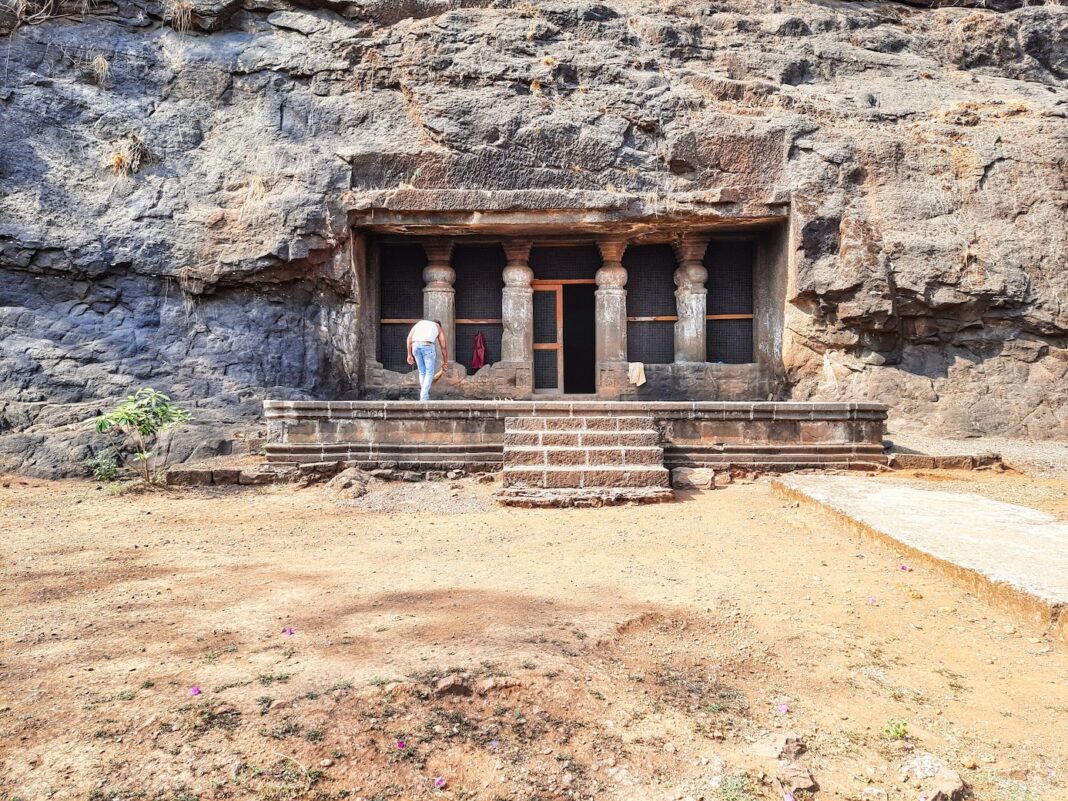The Ambivali Cave (sometimes also called Ambivale Cave in past literature) is situated about 2 km south of Singhdhol village and 5 km west of Jambrung village, in the Raigad district of Maharashtra. Karjat is the main large city in the vicinity of the cave. The cave has been known to the scholar community since 1881 when it was first documented by Burgess. The cave was excavated as a Buddhist vihara (monastery), however, at some later time, it was reappropriated for the Hindu and local gods. As the cave lies away from the coast, it appears that the sustenance of the Buddhist community residing in the cave primarily depended on the local community rather than the trader and merchant communities.
This cave complex consists of a single cave with an adjacent cistern. It is excavated on a long low hill forming the concave side of a curve in the bank of a stream of the River Ulhas. The complex overlooks the river valley. The cave has a front verandah followed by a hall. Presently, it is approachable through a flight of four steps leading to a platform, the latter is of late-period construction. This platform hides the original excavation below the front pillars. The verandah is about 31 feet long, and 6 feet deep.1 It has four pillars in the front. The pillars are raised above a parapet wall. The external side of this wall was decorated with various motifs however, these are all obliterated. The back side of the wall provides benches with sloping back. The middle two pillars have octagonal shafts and the other two pillars have sixteen-sided shafts. Above the shafts are large pot capitals followed by a grooved neck supporting an inverted stepped pyramid consisting of steps with increasing dimensions. The main entrance is provided in the middle. The lateral sides inside the verandah also have benches.
The verandah leads into a hall measuring 42 feet by 39 feet, and 10 feet high.2 There are a total of twelve cells, four cells on each of its three sides. A low bench runs across these three sides. Six cells of the hall have built basements supporting images of various gods and deities. The doorjambs were modified to support doorframes allowing closing the cells. This suggests that at some later period, the cave was reappropriated by Hindus. Burgess says it was occupied by a jogi and the whole of the hall and rock was covered with soot during his visit.
For the identification of the Ambivali cave, Gokhale takes into account a second-century CE inscription on Cave No. 75 at Kanheri. The object of the inscription is to record the gift of a cave to the Chatudisa Bhikhusamgha, a cistern, and a bathing cistern by Lavanika, wife of Achala, a merchant son of Nandana, a house-holder, an inhabitant of Kalyana. He made an endowment of 300 karsapanas to Abalikavihara (i.e. Ambalika Vihara) to defray the cost of clothes of monks, in honor of his parents. Gokhale says the Ambalika Vihara at Kalyan is mentioned thrice in the inscription but so far the side of the vihara has not been located. As Ambivali is located about 8 km south-east of Kalyan, Gokhale suggests the Ambalika Vihara of the inscription refers to the Ambivali caves.3
There are divergent views on the dating of the cave. The absence of a foundation inscription makes the dating more complex. Burgess dates the cave to the first century CE. 4 Dehejia dates the cave to 110-150 CE stating that it is possible that it was commenced earlier, being left incomplete for a period of time.5 Nagaraju dates the cave to the early part of the fourth century CE and mentions the importance of the cave lies in the fact that this provides evidence regarding the continuation of architectural tradition in the so-called ‘gap’ period postulated between the Hinayana and Mahayana phases of rock-cut architecture.6
Inscriptions: There are five inscriptions over the pillars of the hall, one pillar carrying two inscriptions and the other three pillars having one inscription each. Burgess says that on the second pillar of the verandah, on the left of the entrance, is a Pali inscription in one vertical line, reading downward, and there are remains of letters on each of the central pillars but all are indistinct. Dehejia mentions none of the five inscriptions seem to form a complete record and they do not appear to be in Pali. M G Dikshit7 tried to read these inscriptions and his readings are provided below:8
- Ghanapramatha Chapakapramatha
- Chetyavena pa? ra? ya kaha(pana?)
- Jivasiva
- Pusyasiva
- Gri(tri?)susiva
1 Burgess, J & Indrajit, Bhagwanlal (1881). Inscriptions from the Cave Temples of Western India. Government Central Press. Bombay. p. 66
2 Burgess, J & Indrajit, Bhagwanlal (1881). Inscriptions from the Cave Temples of Western India. Government Central Press. Bombay. p. 66
3 Gokhale, Shobhana (1982). An Unpublished Inscriptio from Kanheri published in the Bulletin of the Deccan College Post-Graduate and Research Institute, vol. 41. pp. 77-80
4 Burgess, James (1964). Report on the Buddhist Cave Temples and their Inscriptions. Indological Book House. Varanasi. pp. 10-11
5 Dehejia, Vidya (1972). Early Buddhist Rock Temples – A Chronology. Cornell University Press. New York. ISBN 080140651X. p. 182
6 Nagaraju, S (1981). Buddhist Architecture of Western India. Agam Kala Prakashan. Delhi. p. 106
7 Dikshit, M G (1942). The Origin and Development of the Buddhist Settlements of Western India, Ph.D. thesis submitted to the University of Bombay. p. 72
8 Nagaraju, S (1981). Buddhist Architecture of Western India. Agam Kala Prakashan. Delhi. p. 329
Acknowledgment: Some of the photos above are in CC0 1.0 Universal Public Domain from the collection released by the Tapesh Yadav Foundation for Indian Heritage.

